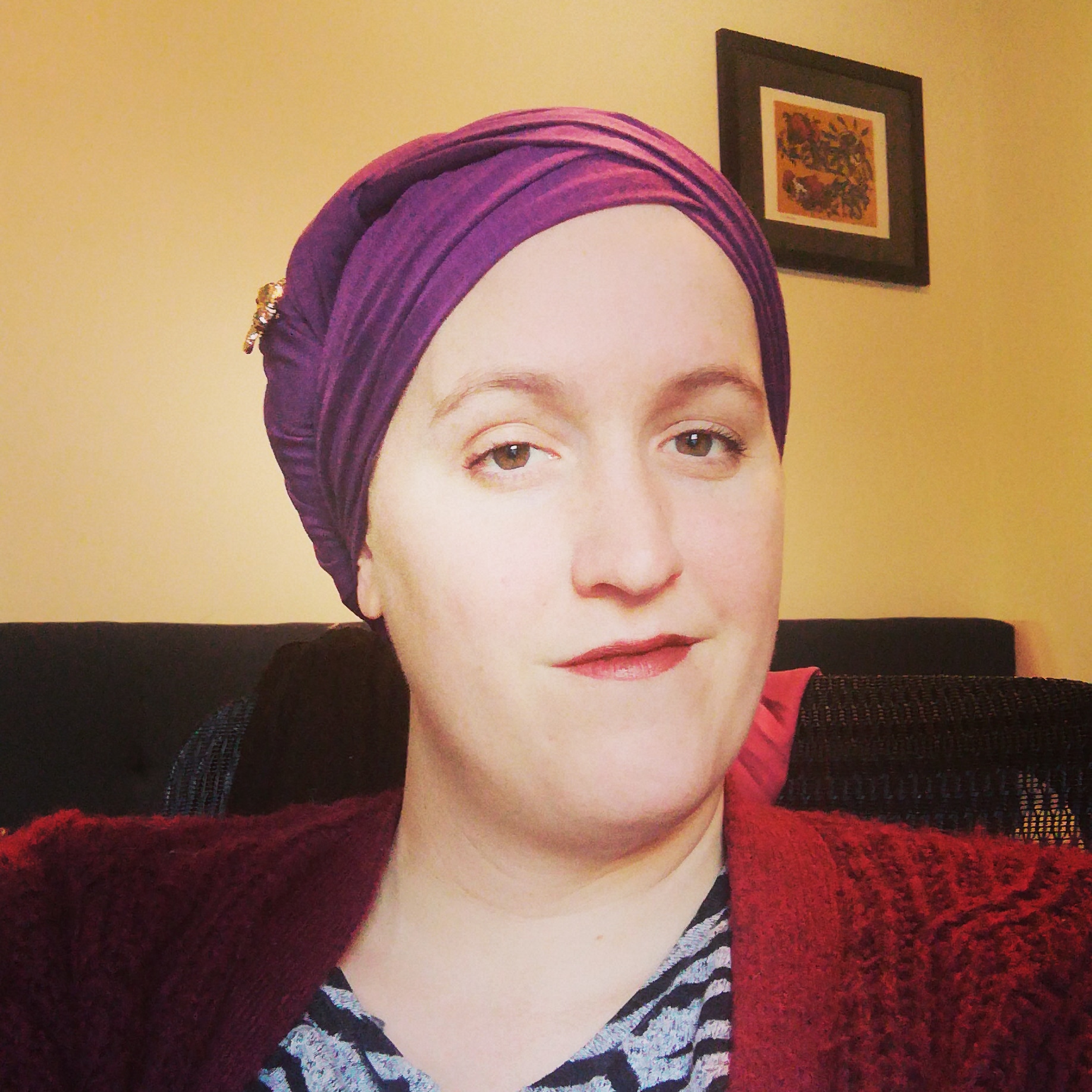Editor’s Note: This teshuvah (legal decision) is one of many already published by Svara’s Trans Halakhah Project that Laynie Soloman described in their Evolve essay, Euphoric Halakhah: The Trans Halakhah Project.
Niddah is most often most simply defined as “Jewish menstrual law.” When I started writing my recently published teshuvah on niddah, Are Trans Women Obligated in Niddah? I was immediately confronted with the question of how to think about halakhic authority as a trans Jewish woman writing trans halakhah. For me, trans halakhah encompasses every beautiful thing that can happen when the Jewish legal process unfolds with the values and wisdom of trans people at its heart. Since our tradition up until now has certainly not, conflict between what my moral intuition dictated and what the sages had to say felt inevitable. It was only by entering into this conundrum with a willingness to embrace whatever I discovered that I was able to find a path that could cross the narrow bridge between trans halakhah and the traditions of the Talmud.
Trans halakhah encompasses every beautiful thing that can happen when the Jewish legal process unfolds with the values and wisdom of trans people at its heart.
The question of whether trans women are obligated in niddah might seem like it has an obvious answer. Trans women definitionally don’t menstruate, and so how could we possibly have anything to do with these mitzvot? Yet, if we go and look at the Torah origins of the practice, we find in Leviticus 15:19:
וְְאִשָּׁה כִּי־תִהְיֶה זָבָה דָּם יִהְיֶה זֹבָהּ בִּבְשָׂרָהּ
And if a woman has an emission, and her emission in her flesh is blood.
The Torah is telling us quite clearly who is implicated in the laws of niddah: women. Trans women are women. This is non-negotiable in any halakhah worth living. And so we also have to accept the corollary then that trans women are, at least generally, obligated in niddah, whether or not we ever have to do anything about that. Generally, niddah has two primary obligations attached to it in our time. The first is practicing sexual abstinence during your niddah period, and the second is immersing in a mikveh at the end of that period. Abstaining from sex and immersing in a mikveh are two things that pretty much anyone can do at any time, so there’s no explicit obstacle to either practice. However, there is still the question of whether there are actually obligations for trans women. Additionally, we’re left with our next question: Even if trans women are obligated in niddah, how would we know when it starts or ends without blood to help us make that decision?
Maimonides has a very unusual understanding of niddah in Chapter 6 of his Issurei Biah that helps us enormously here:
כָּל שִׁבְעַת הַיָּמִים שֶׁנִּקְבְּעָה לָהּ וֶסֶת בִּתְחִלָּתָן הֵן הַנִּקְרָאִין יְמֵי נִדָּתָהּ. בֵּין רָאֲתָה בָּהֶן דָּם בֵּין לֹא רָאֲתָה בָּהֶן דָּם. וּמִפְּנֵי מָה נִקְרָאִין יְמֵי נִדָּה מִפְּנֵי שֶׁהֵן רְאוּיִין לְנִדָּה. וְכָל דָּם שֶׁתִּרְאֶה בָּהֶם דַּם נִדָּה יֵחָשֵׁב וְכָל אַחַד עָשָׂר יוֹם שֶׁאַחַר הַשִּׁבְעָה הֵן הַנִּקְרָאִין יְמֵי זִיבָתָהּ. בֵּין רָאֲתָה בָּהֶן דָּם בֵּין לֹא רָאֲתָה.
For all of the seven days that are established as her cycle, from the outset they are called days of niddah for her. Whether she sees blood in them, or whether she does not see blood in them. And why are they called days of niddah? Because they are fitting for niddah. And any blood she might see in those days is to be considered blood of niddah. And regarding the eleven days that follow the seven, they are declared the days of her zivah. Whether she sees blood in them, or whether she does not.
What is so novel about Maimonides’ take here is not the idea that the potential for niddah status comes and goes in regular cycles, but rather that those cycles keep on going regardless of when or whether a person bleeds when expected. If it’s not the bleeding that drives these metaphysical changes, then what is it? It seems like they are, for him, just a fundamental quality of womanhood. That by being a woman, you’re always taking part in this ebb and flow of niddah potential. You might think that this is all just a misunderstanding because of his misinformed and probably misogynistic projection of how he thinks “women’s bodies” work. And I’d say you’re probably right.
A beautiful thing about our tradition is we get the chance to transform the mistakes of the past by reinterpreting them in the context of the present. Maimonides’ mistaken generalization, probably born of sexist assumptions, can be a gateway through which liberatory halakhah can enter the world. It doesn’t erase the harm or the mistake, but it transforms their context by allowing them to be useful. This is a perfect example of the wisdom that trans halakhah has to offer the world, to offer both cis and trans people. When we approach texts and traditions with assumptions that are fundamental to trans liberation like respect of bodily autonomy and self-definition, we end up with readings that never would have been possible before. Everything old is made new again. And so this strange, idiosyncratic ruling becomes a record of the social construction of Jewish womanhood.
Maimonides’ mistaken generalization, probably born of sexist assumptions, can be a gateway through which liberatory halakhah can enter the world.
When I say the category of “woman” is socially constructed, I mean that rather than having its own independent and inherent reality, womanhood is something we collaboratively create and maintain as a society. It is not an immutable fact about any given person, but rather, a collective narrative that changes and is shaped by each society in its time and place. We can see this niddah cycle as an element of that construction. This is just one of the many ways that the Rabbis and the Rishonim[1] are building their unique version of the category “Jewish woman.”
Another text which gives us a clear example of this construction is found in Niddah 10b:
תנו רבנן חזקה בנות ישראל עד שלא הגיעו לפרקן הרי הן בחזקת טהרה ואין הנשים בודקות אותן משהגיעו לפרקן הרי הן בחזקת טומאה ונשים בודקות אותן
It was taught in a mishnah: There is a legal status regarding the daughters of Israel that until they reach their maturity they have a presumption of purity and women do not examine them. Once they have arrived at their maturity, behold they have a presumption of impurity and women examine them.
The Mishnah’s reading on the beginnings of niddah here informs us about its underpinnings. Whenever women reach womanhood, they enter into a category of presumptive tumah (state of ritual impurity) with regards to objects or people to which that ritual impurity might be transmitted. They enter into this category because of the very fact of their womanhood, as understood and enforced by the Rabbis. This hazakah (legal presumption) certainly applies to trans women as well for the same reasons I discussed before regarding womanhood and the Torah origin of niddah.
You could argue that this hazakah only exists because of the possibility of menstruation that often emerges at this time in someone’s life. However, the rabbis chose to make the basis of the legal presumption according to their own standards of puberty. For them, a girl’s puberty is marked by reaching the age of 12 and having two pubic hairs. The reason the age is lower than boys’ maturation at the age of 13 is because they felt that women naturally mature faster than men. This hazakah of tumah is rooted primarily in rabbinic social models and only secondarily coincides with a hazy margin around the possibility of menstruation. While we might guess at its basis in the potential for menstruation, the fact stands that according to the most direct sense of this text, trans women would acquire this hazakah of tumah on the arrival of our own maturity. In other words, this presumptive status might have some biological parameters, but it is also deeply based on a rabbinic construction of womanhood that we can see unfolding before our eyes in this text.
The power of trans halakhah is that we are emboldened to claim the same tools of this construction for ourselves. Halakhah is and has always been a tool of self-creation. The crux of my argument about niddah, which this and many other texts I’ve included in my teshuvah show us, is that this social construction is fundamental to the halakhah. This means it is not that if someone bleeds, then they are subject to these laws. Rather, if someone is a woman (if we agree with Maimonides), then they are always going through cycles of niddah regardless of the presence or absence of blood. The question remains how to determine when that niddah potential might be actualized in the case of a trans woman, but the fact of her participation in the rhythm of niddah is undeniable.
This rhythmic practice can be invaluable for trans women as an expression of our own genders. When we transition, we use all kinds of tools to express our gender in the world. Hormones, different clothes and pronouns are all ways that we actualize ourselves. By opening the practice of niddah to trans women or rediscovering the way it was already open to us, we have a chance to practice this self-actualization in a Jewish ritual context. This is how trans halakhah can help us see the tradition as our partner, rather than an obstacle, in becoming and expressing our truest and best selves, whether cis or trans.
 When I wrote this teshuvah, I understood my job as being to create halakhic pathways that enable people’s spiritual well-being. I worked the same way the rabbis of the Talmud so often worked: by grounding in my moral intuition and the community’s needs and then finding paths through the text to support them. I thought that would be incredibly difficult, but it turns out that doors had been left open that I could never have imagined. More than any particular rulings about niddah, that discovery of possibility within halakhah has been the gift of this process.
When I wrote this teshuvah, I understood my job as being to create halakhic pathways that enable people’s spiritual well-being. I worked the same way the rabbis of the Talmud so often worked: by grounding in my moral intuition and the community’s needs and then finding paths through the text to support them. I thought that would be incredibly difficult, but it turns out that doors had been left open that I could never have imagined. More than any particular rulings about niddah, that discovery of possibility within halakhah has been the gift of this process.
[1] Early halakhic authorities.








2 Responses
Hi, my name is moshe and I’m currently learning the halachot of nidda and I stumbled upon this essay about trans women and nidda. I’m super interested in knowing more about this.
Thanks
Hey. I am a Jewish transmasculine man who bleeds each month. I love this essay of transgender women and their personal experiences in navigating Niddah and in understanding how they navigate Niddah laws… I’d like to state a subjective sentiment: the Niddah ought to have improvement in gender-inclusivity as it leaves out people of all genders that menstruate (although I do see its origins with designated-female-at-birth (DFAB) or female-centric binary language, there is room for improvement in incorporating gender-inclusivity for people with uteruses (of all genders) that menstruate).
This is a wonderfully well-written article and thank you for writing it.